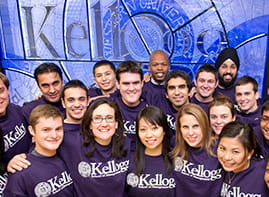Great global brands demand clarity and distinction — and a strategic framework to capture customer value, Kellogg experts say
9/2/2009 -
“People buy things not only for what they can do, but also for what they mean.” — Sidney J. Levy, “Symbols for Sale,” 1959
“Why me?” should be the mantra of every marketer. Not in a hard-luck, sob-story kind of way; but the question should arise whenever the marketing team tries to determine what could make its offering so special that people snap it up at a premium.
Answering that question demands insight into how branding helps make, or break, the sale.
Five decades ago, Kellogg School professors already were cracking marketing’s symbolic codes, unpacking the meaning implicit in the modern incarnation of an older practice—branding.
Branding, in the sense of using hot irons to designate livestock ownership, goes back to antiquity: There are references to brands on tomb walls in ancient Egypt, and the term also was applied poetically to the mythological torches of Cupid and the Furies.
It wasn’t until the 19th century and the mass marketing of packaged goods, though, that commercial branding began to take off. In fact, the Oxford English Dictionary cites 1854 as the first use of the word “brand” to mean “a particular sort or class of goods, as indicated by the trade-marks on them.” But those older, figurative conceptions still hold significance for today’s practitioners.
“The image is as important as the product,” says Peter Tan ’83, executive vice president for Burger King Corporation.
 |
| “Brands function like prisms,” Clinical Professor of Marketing Tim Calkins says. “The brand can elevate or diminish the product.” |
Tan calls attention to brand as a mental perception that customers hold. Branding is about managing those perceptions, he says, and he thinks that marketers should help their firm’s leaders gain better insight into branding’s value. “They need to understand that customers buy brands and
not ‘products.’ You may have the best product, but that product remains with you if you can’t sell it.”
Clinical Professor of Marketing Tim Calkins says that perceptions matter most. Indeed, “how people perceive something matters far more than the absolute truth.” Calkins, author of Breakthrough Marketing Plans (2008) and co-editor of Kellogg on Branding (2005), says that while branding “looks easy” if considered simply from the standpoint of devising “a good name, an attractive logo, and a catchy slogan,” in reality it’s “one of the greatest challenges a manager will face.” As proof, Calkins can list a string of now-defunct brands, including Oldsmobile, Pan Am, pets.com, Yugo and Chemical Bank.
“Brands function like prisms,” he notes. “How people regard a branded product is shaped both by the actual product, such as specific features and attributes, and by the brand. The brand can elevate or diminish the product.”
Given this power, branding holds considerable strategic value, Tan says. While competitors can often reproduce generic products, a strong brand cannot be copied easily and so has “a slower decay rate” in the market.
For Betsy Holden ’82, branding includes “identifying and leveraging your unique strengths and competitive advantages.” A senior adviser to McKinsey & Co. and a former Kraft co-CEO, Holden cites the Kellogg School as a brand that historically has done this, earning a reputation as an academic innovator, especially in the areas of teamwork and executive education. What’s more, while having partnerships and alliances with schools worldwide, Kellogg as a global brand delivers on its promise by providing consistently high-quality education. Such reliability is important to “get right,” Holden says.
“It’s critical to communicate the brand essence and positioning guidelines globally, as this clarity helps local-market managers protect the brand essence,” she says.
Kellogg School Dean Dipak C. Jain, a marketing and innovation expert, says the school’s consistency is a result of its ability to attract top faculty and students in all its programs, including those in its Executive MBA portfolio in Asia, Europe, the Middle East and North America. He says the school’s collaborative culture and leadership mission also help elevate the Kellogg brand. One’s brand must be “sharp, distinct and authentic,” he says, or else risk getting lost in the hypercompetitive marketplace.
“The first step is determining what makes your offering special,” Jain says. “Clarity is key if you want people to remember your value proposition.” Developing an uncluttered brand image may sound simple, but Jain says this takes a surprising amount of insight and discipline. The next step is to convincingly convey this image to a target audience, and then follow through with whatever promises the brand makes.
Brand is important for several reasons, Jain contends, including its function as a “quality signal,” providing a way for consumers to identify superior products or services quickly, thus helping reduce cost-of-thinking. “To me, global brand means excellence — unparalleled quality and reliability,” says Jain, the Sandy and Morton Goldman Professor of Entrepreneurial Studies.
Making the pitch for branding
But what may seem sensible and straightforward arguments for branding can fall flat, especially during a poor economy when companies may be more inclined to cut the marketing budget than increase it. In part, this problem stems from the time that’s typically needed to produce tangible results.
“The journey one takes to build a brand that will yield enduring profitable growth is a long one,” Tan says. The process requires that everyone within the organization understands the “unique selling proposition” and can convey that message enthusiastically so that customers appreciate its distinct value. “You need to have people who understand the industry,” he says, “but you also need people who are engaged, committed and who stay curious to ensure that your brand stays relevant in a fast-changing environment.”
Tan says it’s ideal to have everyone in the company — including top leaders — be willing to “get their hands dirty” on the front lines to learn just how the brand is connecting in the market. “You need people who can traverse seamlessly from the boardroom to the mailroom, talking with employees and customers,” he says.
 |
| Smart companies recognize the role of marketing in creating new demand and increasing revenue, says Scott Davis ’89, author of The Shift: The Transformation of Today’s Marketers into Tomorrow’s Growth Leaders. |
Without this, branding can hit a snag in firms where there is inadequate appreciation for brand strategy and its role in driving growth, according to Scott Davis ’89, senior partner at Prophet, a global consultancy. Making the situation worse are organizational hierarchies that regard the marketing function as a distant silo, rather than an integral partner in the executive suite.
“Marketers have historically been dismissed when they talk about marketing objectives and metrics. We’re measuring awareness levels, brand consideration and brand attributes, all phenomenally important metrics, but are they really in service of driving the company’s growth agenda?” says Davis, who has written three marketing books, including most recently The Shift: The Transformation of Today’s Marketers into Tomorrow’s Growth Leaders. The text explores the history of marketing and articulates the qualities — individual and organizational — required for cultivating “visionary” marketers (think Steve Jobs or Michael Dell) who are key to a firm’s leadership.
Efforts to quantify brand, such as the annual BusinessWeek/Interbrand “Best Global Brands” ranking, have helped make the connection between image and revenue. Since 1999, the survey has attempted to capture various brand factors, including financial strength, ability to influence customer choice, and potential future earnings. In 2008, the survey’s top global brand was Coca-Cola, worth nearly $67 billion. IBM, Microsoft, GE, Nokia, Toyota, Intel, McDonald’s, Disney and Google rounded out the survey’s top 10 spots.
Such metrics suggest that smart marketers are not consumed with logo tinkering, but instead are trying to change the organizational dialogue about marketing by shifting their team’s goals and investments in ways that impact the company’s bottom line.
“They are changing the back-end discussion around how we measure success,” Davis says. “It’s around margin. It’s around helping to drive cost-of-serve down. It’s around driving revenues up and creating new demand in new markets, new segments, new geographies and new white spaces.
“It sounds really big, and it is big, because it’s the company’s growth agenda.”
Continue Reading






